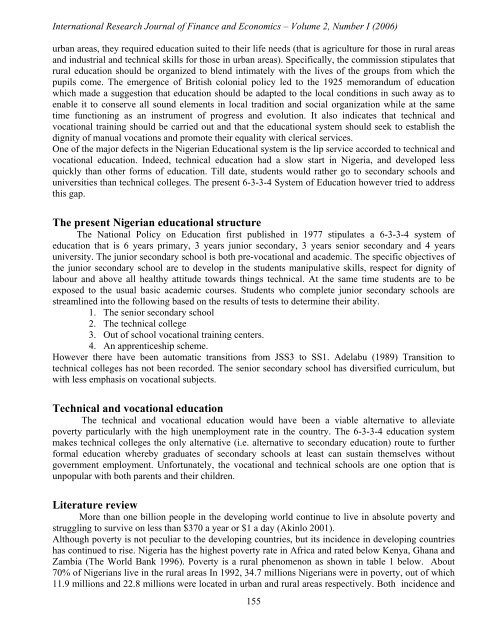EFFECT OF VITAMINS C AND E INTAKE ON BLOOD ... - EuroJournals
EFFECT OF VITAMINS C AND E INTAKE ON BLOOD ... - EuroJournals
EFFECT OF VITAMINS C AND E INTAKE ON BLOOD ... - EuroJournals
You also want an ePaper? Increase the reach of your titles
YUMPU automatically turns print PDFs into web optimized ePapers that Google loves.
International Research Journal of Finance and Economics – Volume 2, Number I (2006)<br />
urban areas, they required education suited to their life needs (that is agriculture for those in rural areas<br />
and industrial and technical skills for those in urban areas). Specifically, the commission stipulates that<br />
rural education should be organized to blend intimately with the lives of the groups from which the<br />
pupils come. The emergence of British colonial policy led to the 1925 memorandum of education<br />
which made a suggestion that education should be adapted to the local conditions in such away as to<br />
enable it to conserve all sound elements in local tradition and social organization while at the same<br />
time functioning as an instrument of progress and evolution. It also indicates that technical and<br />
vocational training should be carried out and that the educational system should seek to establish the<br />
dignity of manual vocations and promote their equality with clerical services.<br />
One of the major defects in the Nigerian Educational system is the lip service accorded to technical and<br />
vocational education. Indeed, technical education had a slow start in Nigeria, and developed less<br />
quickly than other forms of education. Till date, students would rather go to secondary schools and<br />
universities than technical colleges. The present 6-3-3-4 System of Education however tried to address<br />
this gap.<br />
The present Nigerian educational structure<br />
The National Policy on Education first published in 1977 stipulates a 6-3-3-4 system of<br />
education that is 6 years primary, 3 years junior secondary, 3 years senior secondary and 4 years<br />
university. The junior secondary school is both pre-vocational and academic. The specific objectives of<br />
the junior secondary school are to develop in the students manipulative skills, respect for dignity of<br />
labour and above all healthy attitude towards things technical. At the same time students are to be<br />
exposed to the usual basic academic courses. Students who complete junior secondary schools are<br />
streamlined into the following based on the results of tests to determine their ability.<br />
1. The senior secondary school<br />
2. The technical college<br />
3. Out of school vocational training centers.<br />
4. An apprenticeship scheme.<br />
However there have been automatic transitions from JSS3 to SS1. Adelabu (1989) Transition to<br />
technical colleges has not been recorded. The senior secondary school has diversified curriculum, but<br />
with less emphasis on vocational subjects.<br />
Technical and vocational education<br />
The technical and vocational education would have been a viable alternative to alleviate<br />
poverty particularly with the high unemployment rate in the country. The 6-3-3-4 education system<br />
makes technical colleges the only alternative (i.e. alternative to secondary education) route to further<br />
formal education whereby graduates of secondary schools at least can sustain themselves without<br />
government employment. Unfortunately, the vocational and technical schools are one option that is<br />
unpopular with both parents and their children.<br />
Literature review<br />
More than one billion people in the developing world continue to live in absolute poverty and<br />
struggling to survive on less than $370 a year or $1 a day (Akinlo 2001).<br />
Although poverty is not peculiar to the developing countries, but its incidence in developing countries<br />
has continued to rise. Nigeria has the highest poverty rate in Africa and rated below Kenya, Ghana and<br />
Zambia (The World Bank 1996). Poverty is a rural phenomenon as shown in table 1 below. About<br />
70% of Nigerians live in the rural areas In 1992, 34.7 millions Nigerians were in poverty, out of which<br />
11.9 millions and 22.8 millions were located in urban and rural areas respectively. Both incidence and<br />
155
















